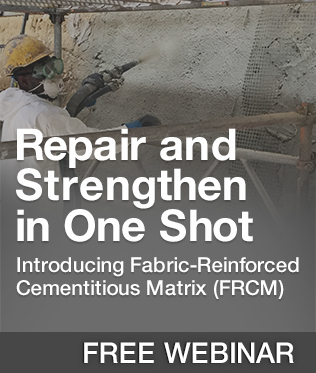Our thoughts go out to everyone affected by Hurricane Harvey and this disaster in Texas. To help with relief efforts we are donating $50,000 to the American Red Cross Disaster Relief Fund. Employees at our Houston warehouse are safe and the employees from our McKinney branch will be doing as much as they can to help with relief efforts.
On July 25, 2017, Simpson Strong-Tie hosted the second interactive webinar in the Simpson Strong-Tie FRP Best Practices Series, “Advanced FRP Design Principles,” in which Kevin Davenport, P.E. – one of our Field Engineering Managers – and I discussed the best practices for fiber-reinforced polymer (FRP) strengthening design. The webinar examines the latest industry standards, proper use of material properties, and key governing limits when designing with FRP and discusses the assistance and support Simpson Strong-Tie Engineering Services offers from initial project assessment to installation. Watch the on-demand webinar and earn PDH and CEU credits here.

During the live webinar, we had the pleasure of taking questions from attendees during the Q&A session. Here is a curated selection of Q&A from that session:
While I see how you improve the flexural capacity of a beam, how do you increase its shear capacity to match new moment strength?
ACI 440.2R recommends checking the element for shear if FRP is used to increase flexural strength. U-wraps can be used to provide shear strengthening of a beam.
Are there any “pre-check” serviceability checks (deflection, vibration, etc.) similar to the ACI 440 strength check that you recommend when considering the use of FRP?
ACI 440.2R contains a few serviceability checks on the concrete, rebar and FRP that can be performed once you have designed a preliminary strengthening solution.
Are these strengthening limits for gravity loads only? What about for a seismic load combination?
Yes, the strengthening limits are just for gravity loading. Seismic loading does not require an existing capacity check as it is highly unlikely for the FRP to be damaged during a lateral event.
Did Simpson Strong-Tie perform load tests on FRP repaired timber piles?
We are currently testing our FRP products as applied to timber piles at West Virginia University. We have also implemented a full-scale testing program on damaged timber piles at our own lab using our FX-70® fiberglass jacket system.
Will any of your seminars cover FRP and CMU? Seismic applications?
Yes, these are topics we are considering for future webinars.
The 0.6 limit for compressive stress can be very limiting. Can this value be evaluated on a case-by-case basis? The Euro code allows higher limits on compressive stress?
Our designers will report this value, along with the section addressing this check from ACI 440.2R, to the EOR and discuss whether the EOR would like to proceed with the FRP strengthening on his or her project.
Which engineer (EOR or Delegated Engineer) is responsible for specifying the scope of special inspections?
We provide a draft FRP specification to the EOR to use in their final determination of the special inspection requirements for a project. It’s in the owner’s best interest to hire a qualified special inspection agency on an FRP installation project.
For complete information regarding specific products suitable to your unique situation or condition, please visit strongtie.com/css or call your local Simpson Strong-Tie RPS specialist at (800) 999-5099.
Learn more: Webinar – Introducing Fabric-Reinforced Cementitious Matrix (FRCM)
In this free webinar we dive into some very important considerations including the latest industry standards, material properties and key governing limits when designing with FRCM.
Continuing education credits will be offered for this webinar.
Participants can earn one professional development hour (PDH) or 0.1 continuing education unit (CEU).



